Opposition and Identicalness: Two Basic Components of Adults’ Perception and Mental Representation of Symmetry
Abstract
:1. Introduction
From Mirrors to Mirror Symmetry
2. Study 1
2.1. Materials and Method
2.1.1. Participants
2.1.2. Materials
- (1)
- How would you define the relationship between two symmetrical shapes?
- (2)
- Draw a clear example of your idea of two symmetrical shapes.
- (3)
- Draw another clear example (radically different from the first two) of your idea of two symmetrical shapes.
- (4)
- Which of the following three definitions best describes your idea of symmetry?
- (a)
- Two identical shapes
- (b)
- Two opposite shapes
- (c)
- Two identical and opposite shapes
2.1.3. Procedure
2.1.4. Statistical Analysis
2.1.5. Results
- (a)
- Exclusive references to Sameness were significantly more frequent than references to both Sameness and Opposition (categories b versus f in Table 1: EST = 1.292, SE = 0.334, z-ratio = 3.863, p = 0.003, d = 0.376);
- (b)
- The two most frequent types of description (i.e., categories b and c in Table 1), which together amount to 61% of the total number of responses, do not explicitly refer to opposition;
- (c)
- Only one response (i.e., less than 1%) mentioned the opposition component exclusively (category e in Table 1: “Two symmetrical shapes are two opposite shapes”);
- (d)
- Overall Opposition, in one way or another (i.e., categories e, f, and g in Table 1) was mentioned in only 20 out of the 105 descriptions collected (i.e., 19.04%).
3. Study 2
3.1. Materials and Method
3.1.1. Participants
3.1.2. Materials
3.1.3. Procedure
3.1.4. Statistical Analysis
3.1.5. Results
4. Discussion
Potential Impact and Limitations of the Study
Acknowledgments
Author Contributions
Conflicts of Interest
References
- Wagemans, J. Detection of visual symmetries. Spat. Vis. 1995, 9, 9–32. [Google Scholar] [CrossRef] [PubMed]
- Treder, M.S. Behind the looking-glass: A review on human symmetry perception. Symmetry 2010, 2, 1510–1543. [Google Scholar] [CrossRef]
- Eisenman, R. Preference for symmetry and the rejection of complexity. Psychon. Sci. 1967, 8, 169–170. [Google Scholar] [CrossRef]
- Enquist, M.; Arak, A. Symmetry, beauty and evolution. Nature 1994, 372, 169–172. [Google Scholar] [CrossRef] [PubMed]
- Enquist, M.; Johnstone, R.A. Generalization and the evolution of symmetry preferences. Proc. R. Soc. B Biol. Sci. 1997, 264, 1345–1348. [Google Scholar] [CrossRef]
- Jacobsen, T.; Hofel, L. Descriptive and evaluative judgment processes: Behavioral and electrophysiological indices of processing symmetry and aesthetics. Cognit. Affect. Behav. Neurosci. 2003, 3, 289–299. [Google Scholar] [CrossRef]
- Chen, C.C.; Wu, J.H.; Wu, C.C. Reduction of image complexity explains aesthetic preference for symmetry. Symmetry 2011, 3, 443–456. [Google Scholar] [CrossRef]
- Makin, A.D.J.; Bertamini, M.; Jones, A.; Holmes, T.; Zanker, J.M. A gaze-driven evolutionary algorithm to study aesthetic evaluation of visual symmetry. i-Perception 2016, 7. [Google Scholar] [CrossRef] [PubMed]
- Pecchinenda, A.; Bertamini, M.; Makin, A.D.J.; Ruta, N. The pleasantness of visual symmetry: Always, never or sometimes. PLoS ONE 2014, 9, e92685. [Google Scholar] [CrossRef] [PubMed]
- Bertamini, M.; Makin, A. Brain activity in response to visual symmetry. Symmetry 2014, 6, 975–996. [Google Scholar] [CrossRef]
- Cattaneo, Z. The neural basis of mirror symmetry detection: A review. J. Cognit. Psychol. 2017, 29, 259–268. [Google Scholar] [CrossRef]
- Pornstein, M.H.; Krinsky, S.J. Perception of symmetry in infancy—The salience of vertical symmetry and the perception of pattern wholes. J. Exp. Child Psychol. 1985, 39, 1–19. [Google Scholar] [CrossRef]
- Tyler, C.W.; Hardage, L.; Miller, R.T. Multiple mechanisms for the detection of mirror symmetry. Spat. Vis. 1995, 9, 79–100. [Google Scholar] [CrossRef] [PubMed]
- Wenderoth, P. The salience of vertical symmetry. Perception 1994, 23, 221–236. [Google Scholar] [CrossRef] [PubMed]
- Wenderoth, P. The effects of dot pattern parameters and constraints on the relative salience of vertical bilateral symmetry. Vis. Res 1996, 36, 2311–2320. [Google Scholar] [CrossRef]
- Bianchi, I.; Burro, R.; Pezzola, R.; Savardi, U. Matching visual and acoustic mirror forms. Symmetry 2017, 9, 39. [Google Scholar] [CrossRef]
- Cattaneo, Z.; Vecchi, T.; Fantino, M.; Herbert, A.M.; Merabet, L.B. The effect of vertical and horizontal symmetry on memory for tactile patterns in late blind individuals. Atten. Percept. Psychophys. 2013, 75, 375–382. [Google Scholar] [CrossRef] [PubMed]
- Wagemans, J.; Vangool, L.; Dydewalle, G. Detection of symmetry in tachistoscopically presented dot patterns—Effects of multiple axes and skewing. Atten. Percept. Psychophys. 1991, 50, 413–427. [Google Scholar] [CrossRef]
- Wagemans, J. Characteristics and models of human symmetry detection. Trends Cognit. Sci. 1997, 1, 346–352. [Google Scholar] [CrossRef]
- Csatho, A.; van der Vloed, G.; van der Helm, P.A. Blobs strengthen repetition but weaken symmetry. Vis. Res. 2003, 43, 993–1007. [Google Scholar] [CrossRef]
- Csatho, A.; van der Vloed, G.; van der Helm, P.A. The force of symmetry revisited: Symmetry-to-noise ratios regulate (a) symmetry effects. Acta Psychol. 2004, 117, 233–250. [Google Scholar] [CrossRef] [PubMed]
- Dastani, M.; Scha, R. Languages for gestalts of line patterns. J. Math. Psychol. 2003, 47, 429–449. [Google Scholar] [CrossRef]
- Nucci, M.; Wagemans, J. Goodness of regularity in dot patterns: Global symmetry, local symmetry, and their interactions. Perception 2007, 36, 1305–1319. [Google Scholar] [CrossRef] [PubMed]
- Olivers, C.N.L.; Chater, N.; Watson, G.D. Holography does not account for goodness: A critique of van der Helm and Leeuwenberg (1996). Psychol. Rev. 2004, 11, 242–260. [Google Scholar] [CrossRef] [PubMed]
- Palmer, S.E. Symmetry, transformation, and the structure of perceptual systems. In Organization and Representation in Perception; Beck, J., Ed.; Lawrence Erlbaum Associates: Hillsdale, NJ, USA, 1982; pp. 95–144. [Google Scholar]
- Palmer, S.E. The psychology of perceptual organization: A transformational approach. In Human and Machine Vision; Beck, J., Hope, B., Rosenfeld, A., Eds.; Academic Press: New York, NY, USA, 1983; Volume 1, pp. 269–339. [Google Scholar]
- Vanderhelm, P.A.; Leeuwenberg, E.L.J. Accessibility—A criterion for regularity and hierarchy in visual-pattern codes. J. Math. Psychol. 1991, 35, 151–213. [Google Scholar] [CrossRef]
- VanderHelm, P.A.; Leeuwenberg, E.L.J. Goodness of visual regularities: A nontransformational approach. Psychol. Rev. 1996, 103, 429–456. [Google Scholar] [CrossRef]
- VanderHelm, P.A.; Leeuwenberg, E.L.J. A Better Approach to Goodness: Reply to Wagemans. Psychol. Rev. 1999, 106, 622–630. [Google Scholar] [CrossRef]
- VanderHelm, P.A.; Leeuwenberg, E.L.J. Holographic Goodness Is Not That Bad: Reply to Olivers, Chater, and Watson. Psychol. Rev. 2004, 111, 261–273. [Google Scholar] [CrossRef]
- Wagemans, J.; Van Gool, L.; Swinnen, V.; Van Horebeek, J. Higher-order structure in regularity detection. Vis. Res. 1993, 33, 1067–1088. [Google Scholar] [CrossRef]
- Wagemans, J. Toward a better approach to goodness: Comments on van der helm and leeuwenberg (1996). Psychol. Rev. 1999, 106, 610–621. [Google Scholar] [CrossRef]
- Makin, A.D.; Wright, D.; Rampone, G.; Palumbo, L.; Guest, M.; Sheehan, R.; Cleaver, H.; Bertamini, M. An electrophysiological index of perceptual goodness. Cereb. Cortex 2016, 26, 4416–4434. [Google Scholar] [CrossRef] [PubMed]
- Bianchi, I.; Savardi, U. The opposite of a figure. Gestalt Theory 2006, 4, 354–374. [Google Scholar]
- Bianchi, I.; Savardi, U. The Perception of Contraries; Aracne: Roma, Italy, 2008. [Google Scholar]
- Gati, I.; Tversky, A. Weighting Common and Distinctive Features in Perceptual and Conceptual Judgments. Cognit. Psychol. 1984, 16, 341–370. [Google Scholar] [CrossRef]
- Gati, I.; Tversky, A. Recall of common and distinctive features of verbal and pictorial stimuli. Mem. Cognit. 1987, 15, 97–100. [Google Scholar] [CrossRef] [PubMed]
- Goldmeier, E. Similarity in visually perceived forms. Psychol. Issues 1972, 29, 1–131. [Google Scholar]
- Medin, D.L.; Goldston, R.L.; Gentner, D. Similarity involving attributes and relations: Judgments of similarity and difference are not inverses. Psychol. Sci. 1990, 1, 64–69. [Google Scholar] [CrossRef]
- Rock, I. Orientation and Form; Academic Press: New York, NY, USA, 1973. [Google Scholar]
- Sattath, S.; Tversky, A. On the Relation between Common and Distinctive features Models. Psychol. Rev. 1987, 94, 16–22. [Google Scholar] [CrossRef]
- Tversky, A. Features of similarity. Psychol. Rev. 1977, 84, 327–352. [Google Scholar] [CrossRef]
- Baylis, G.C.; Driver, J. Obligatory edge assignment in vision: The role of figure and part segmentation in symmetry detection. J. Exp. Psychol. Hum. Percept. Perform. 1995, 21, 1323–1342. [Google Scholar] [CrossRef]
- Koning, A.; Wagemans, J. Detection of symmetry and repetition in one and two objects: Structures versus strategies. Exp. Psychol 2009, 56, 5–17. [Google Scholar] [CrossRef] [PubMed]
- Weyl, H. Symmetry; Princeton University Press: Princeton, NJ, USA, 2016. [Google Scholar]
- Kubovy, M. Phenomenology, psychological. In Encyclopedia of Cognitive Science; Nadel, L., Ed.; Macmillan: Hampshire, UK, 2002; pp. 579–586. [Google Scholar]
- Thinés, G.; Costall, A.; Butterworth, G. Michotte’s Experimental Phenomenology of Perception, 2nd ed.; Routledge: Oxford, UK, 2015. [Google Scholar]
- Wagemans, J.; Elder, J.H.; Kubovy, M.; Palmer, S.E.; Peterson, M.A.; Singh, M. A Century of Gestalt Psychology in Visual Perception I. Perceptual Grouping and Figure-Ground Organization. Psychol. Bull. 2012, 138, 1172–1217. [Google Scholar] [PubMed]
- Wagemans, J.; Feldman, J.; Gepshtein, S.; Kimchi, R.; Pomerantz, J.R.; van der Helm, P.A.; van Leeuwen, C. A century of Gestalt psychology in visual perception: II. Conceptual and theoretical foundations. Psychol. Bull. 2012, 138, 1218–1252. [Google Scholar] [CrossRef] [PubMed]
- Croucher, C.J.; Bertamini, M.; Hecht, H. Naïve optics: Understanding the geometry of mirror reflections. J. Exp. Psychol. Hum. 2002, 28, 546–562. [Google Scholar] [CrossRef]
- Bianchi, I.; Savardi, U. What fits into a mirror: Naïve beliefs about the field of view. J. Exp. Psychol. Hum. Percept. Perform. 2012, 38, 1144–1158. [Google Scholar] [CrossRef] [PubMed]
- Kaiser, M.K.; Proffitt, D.R.; McCloskey, M. The development of beliefs about falling objects. Percept. Psychophys. 1985, 38, 533–539. [Google Scholar] [CrossRef] [PubMed]
- Huber, S.; Krist, H. When is the ball going to hit the ground? Duration estimates, eye movements, and mental imagery of object motion. J. Exp. Psychol. Hum. Percept. Perform. 2004, 30, 431–444. [Google Scholar] [CrossRef] [PubMed]
- McCloskey, M.; Washburn, A.; Felch, L. Intuitive physics: The straight-down belief and its origin. J. Exp. Psychol. Learn. Mem. Cognit. 1983, 9, 636–649. [Google Scholar] [CrossRef]
- Shanon, B. Aristotelianism, newtonianism and the physics of the layman. Perception 1976, 5, 241–243. [Google Scholar] [CrossRef] [PubMed]
- Hecht, H.; Bertamini, M. Understanding projectile acceleration. J. Exp. Psychol. Hum. Percept. Perform. 2000, 26, 730–746. [Google Scholar] [CrossRef] [PubMed]
- McCloskey, M.; Caramazza, A.; Green, B. Curvilinear motion in the absence of external forces: Naïve beliefs about the motion of objects. Science 1980, 210, 1139–1141. [Google Scholar] [CrossRef] [PubMed]
- McAfee, E.A.; Proffitt, D.R. Understanding the surface orientation of liquids. Cognit. Psychol. 1991, 23, 483–514. [Google Scholar] [CrossRef]
- Sholl, M.J.; Liben, L.S. Illusory tilt and Euclidean schemes as factors in performance on the water-level task. J. Exp. Psychol. Learn. Mem. Cognit. 1995, 21, 1624–1638. [Google Scholar] [CrossRef]
- Yates, J.; Bessman, M.; Dunne, M.; Jertson, D.; Sly, K.; Wendelboe, B. Are conceptions of motion based on a naïve theory or on prototypes? Cognition 1988, 29, 251–275. [Google Scholar] [CrossRef]
- Gregory, R.L. Mirrors in Mind; Freeman Spektrum: New York, NY, USA, 1966. [Google Scholar]
- Gregory, R.L. Mirror reversals. In The Oxford Companion to the Mind; Gregory, R.L., Ed.; Oxford University Press: Oxford, UK, 1987; pp. 491–493. [Google Scholar]
- Hecht, H.; Bertamini, M.; Gamer, M. Naïve optics: Acting on mirror reflections. J. Exp. Psychol. Hum. Percept. Perform. 2005, 31, 1023–1038. [Google Scholar] [CrossRef] [PubMed]
- Muelenz, C.; Hecht, H.; Gamer, M. Testing the egocentric mirror-rotation hypothesis. Seeing Perceiving 2010, 23, 373–383. [Google Scholar] [CrossRef] [PubMed]
- Bianchi, I.; Savardi, U. Contrariety in plane mirror reflections. In The Perception and Cognition of Contraries; Savardi, U., Ed.; Mc-Graw Hill: Milan, Italy, 2009; pp. 113–128. [Google Scholar]
- Bianchi, I.; Savardi, U. Grounding naïve physics and optics in perception. Balt. Int. Yearb. Cognit. Log. Commun. 2014, 6. [Google Scholar] [CrossRef]
- Savardi, U.; Bianchi, I.; Bertamini, M. Naïve predictions of motion and orientation in mirrors: From what we see to what we expect reflections to do. Acta Psychol. 2010, 134, 1–15. [Google Scholar] [CrossRef] [PubMed]
- Bertamini, M.; Spooner, A.; Hecht, H. Naïve optics: Predicting and perceiving reflections in mirrors. J. Exp. Psychol. Hum. Percept. Perform. 2003, 29, 982–1002. [Google Scholar] [CrossRef] [PubMed]
- Bianchi, I.; Bertamini, M.; Savardi, U. Differences between predictions of how a reflection behaves based on the behaviour of an object, and how an object behaves based on the behaviour of its reflection. Acta Psychol. 2015, 161, 54–63. [Google Scholar] [CrossRef] [PubMed]
- Bianchi, I.; Savardi, U. The relationship perceived between the real body and the mirror image. Perception 2008, 37, 666–687. [Google Scholar] [CrossRef] [PubMed]
- Bianchi, I.; Savardi, U.; Burro, R.; Martelli, M.F. Doing the opposite to what another person is doing. Acta Psychol. 2014, 151, 117–133. [Google Scholar] [CrossRef] [PubMed] [Green Version]
- Bates, D.; Machler, M.; Bolker, B.M.; Walker, S.C. Fitting linear mixed-effects models using lme4. arXiv, 2015; arXiv:1406.5823. [Google Scholar]
- Lenth, R.V. Least-squares means: The R package lsmeans. J. Stat. Softw. 2016, 69, 1–33. [Google Scholar] [CrossRef]
- Kuznetsova, A.; Bruun, B.P.; Haubo, B.C.R. lmerTest: Tests in Linear Mixed Effects Models. R Package Version 2.0-33. 2016. Available online: https://CRAN.R-project.org/package=lmerTest (accessed on 3 December 2016).
- Cohen, J. Statistical Power Analysis for the Behavioral Sciences, 2nd ed.; Academic Press: New York, NY, USA, 1988. [Google Scholar]
- Friendly, M. Mosaic displays for multi-way contingency tables. J. Am. Stat. Assoc. 1994, 89, 190–200. [Google Scholar] [CrossRef]
- Friendly, M. Visualizing Categorical Data. SAS Institute: Cary, NC, USA, 2000. Available online: http://www.math.yorku.ca/SCS/vcd/ (accessed on 25 December 2000).
- Meyer, D.; Zeileis, A.; Hornik, K. The Strucplot framework: Visualizing multi-way contingency tables with vcd. J. Stat. Softw. 2006, 17, 1–48. [Google Scholar] [CrossRef]
- Ravelle, W. psych: Procedures for Personality and Psychological Research; Northwestern University: Evanston, IL, USA, 2017. [Google Scholar]
- Bertamini, M.; Friedenberg, J.D.; Kubovy, M. Detection of symmetry and perceptual organization: The way a lock-and-key process works. Acta Psychol. 1997, 95, 119–140. [Google Scholar] [CrossRef]
- Strother, L.; Kubovy, M. Perceived complexity and the grouping effect in band patterns. Acta Psychol. 2003, 114, 229–244. [Google Scholar] [CrossRef]
- Bertamini, M.; Makin, A.D.J.; Rampone, G. Implicit association of symmetry with positive valence, high arousal and simplicity. i-Perception 2013, 4, 317–327. [Google Scholar] [CrossRef]
- Cardenas, R.A.; Harris, L.J. Symmetrical decorations enhance the attractiveness of faces and abstract designs. Evol. Hum. Behav. 2006, 27, 1–18. [Google Scholar] [CrossRef]
- Eysenck, H.J.; Castle, M. Training in art as a factor in the determination of preference judgements for polygons. Br. J. Psychol. 1970, 61, 65–81. [Google Scholar] [CrossRef] [PubMed]
- Jacobsen, T.; Hofel, L. Aesthetic judgments of novel graphic patterns: Analyses of individual judgments. Percept. Mot. Skills 2002, 95, 755–766. [Google Scholar] [CrossRef] [PubMed]
- Kubovy, M.; Strother, L. The perception of band patterns: Going beyond geometry. In Embedded Symmetries, Natural and Cultural; Washburn, D., Ed.; Amerind Foundation and University of New Mexico Press: Albuquerque, NM, USA, 2004; pp. 19–26. [Google Scholar]
- Makin, A.D.J.; Pecchinenda, A.; Bertamini, M. Implicit affective evaluation of visual symmetry. Emotion 2012, 12, 1021–1030. [Google Scholar] [CrossRef] [PubMed]
- Erlikhman, G.; Strother, L.; Barzakov, I.; Caplovitz, G.P. On the Legibility of Mirror-Reflected and Rotated Text. Symmetry 2017, 9, 28. [Google Scholar] [CrossRef]
- Danziger, E.; Pederson, E. Through the looking glass: Literacy, writing systems and mirror image discrimination. Writ. Lang. Lit. 1998, 1, 153–169. [Google Scholar] [CrossRef]
- Kolinsky, R.; Verhaeghe, A.; Fernandes, T.; Mengarda, E.J.; Grimm-Cabral, L.; Morais, J. Enantiomorphy through the looking glass: Literacy effects on mirror-image discrimination. J. Exp. Psychol. Gen. 2011, 140, 210–238. [Google Scholar] [CrossRef] [PubMed]
- Pegado, F.; Nakamura, K.; Braga, L.W.; Ventura, P.; Nunes Filho, G.; Pallier, C.; Jobert, A.; Morais, J.; Cohen, L.; Kolinsky, R.; et al. Literacy breaks mirror invariance for visual stimuli: A behavioral study with adult illiterates. J. Exp. Psychol. Gen. 2014, 143, 887–894. [Google Scholar] [CrossRef] [PubMed]
- Borst, G.; Ahr, E.; Roell, M.; Houdé, O. The cost of blocking the mirror generalization process in reading: Evidence for the role of inhibitory control in discriminating letters with lateral mirror-image counterparts. Pysychon. Bull. Rev. 2015, 22, 228–234. [Google Scholar] [CrossRef] [PubMed]
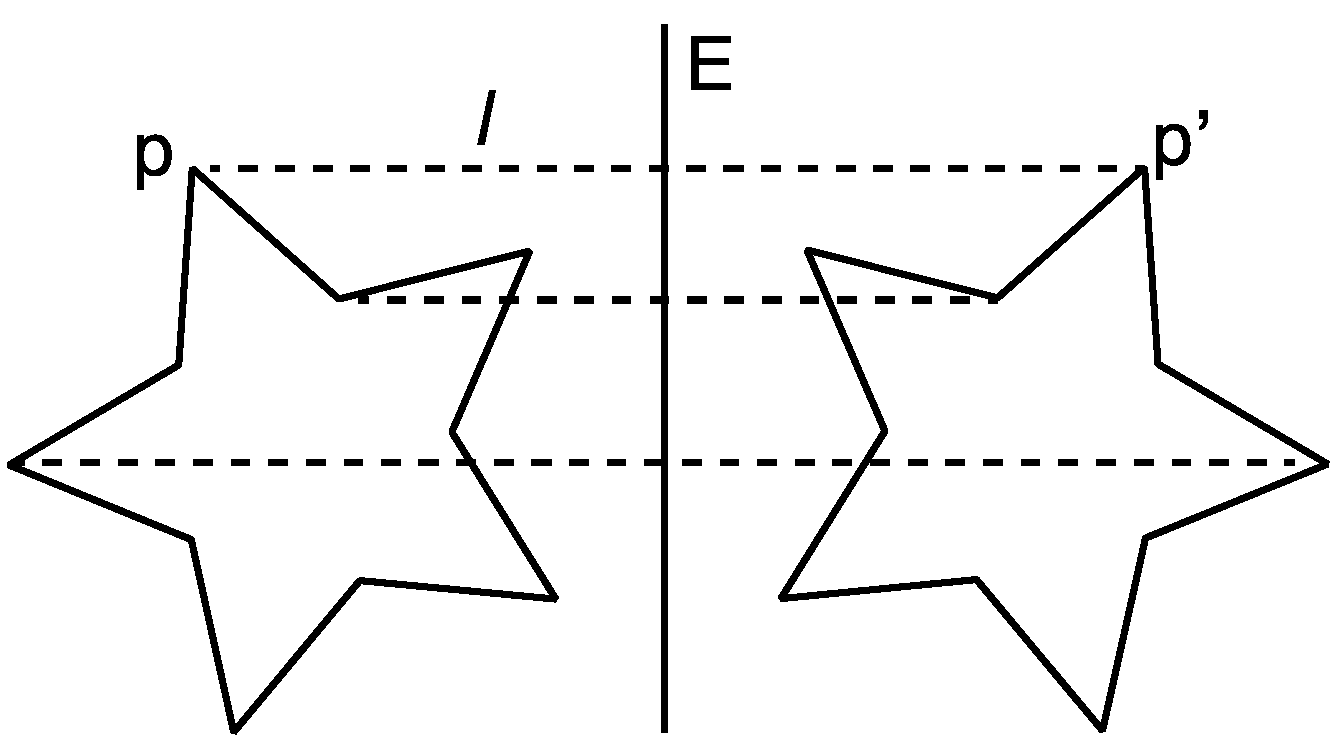
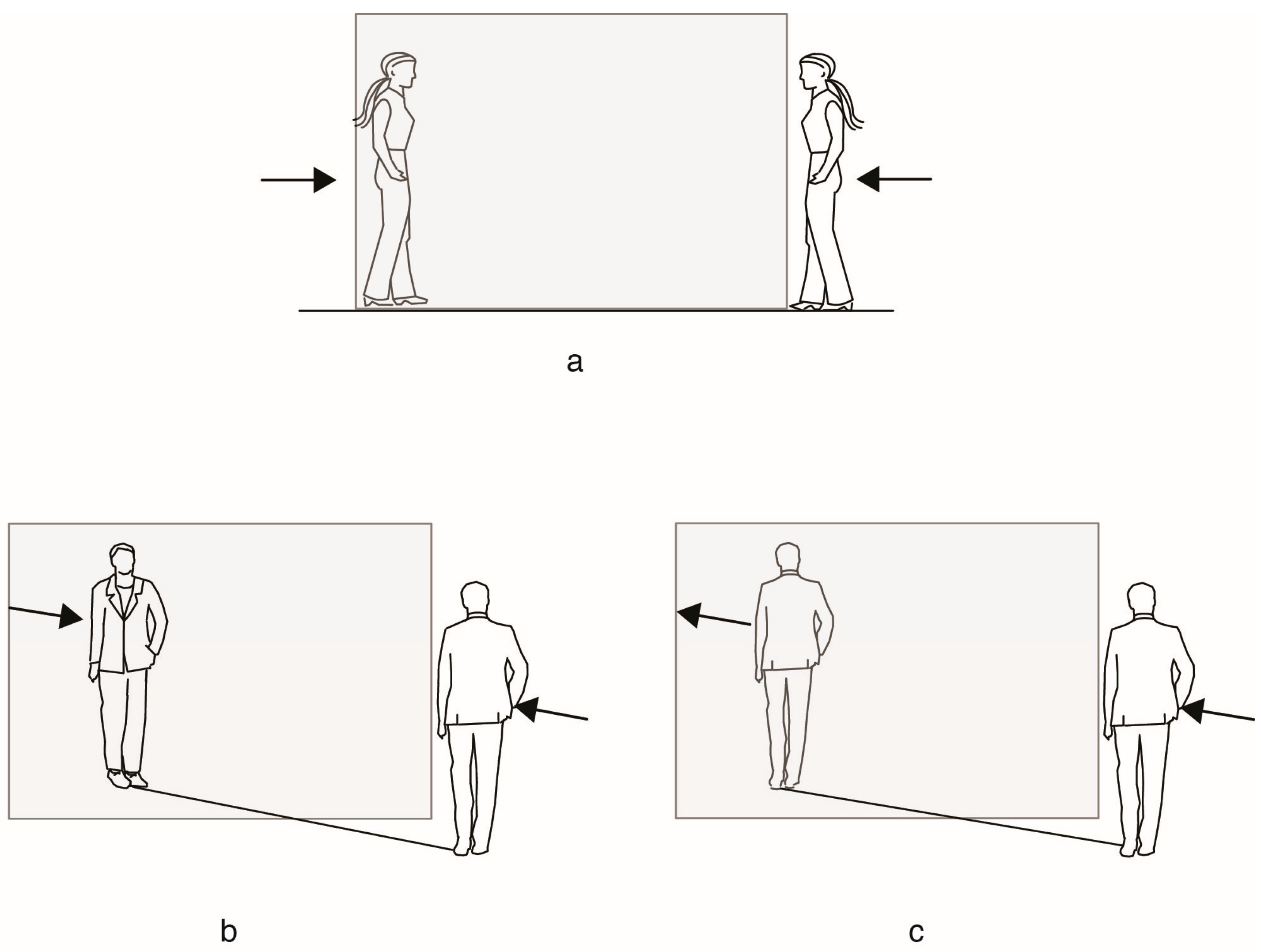
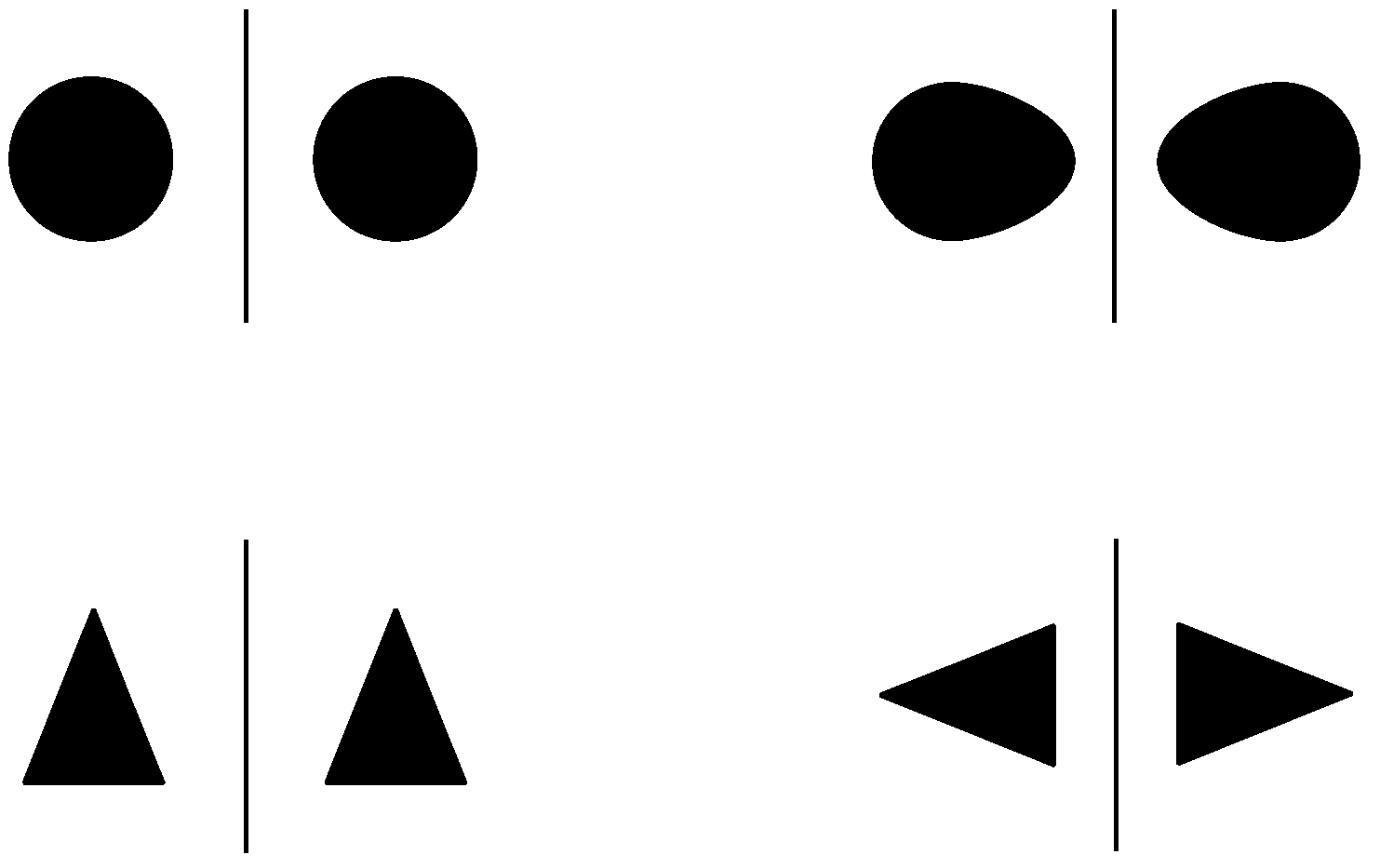
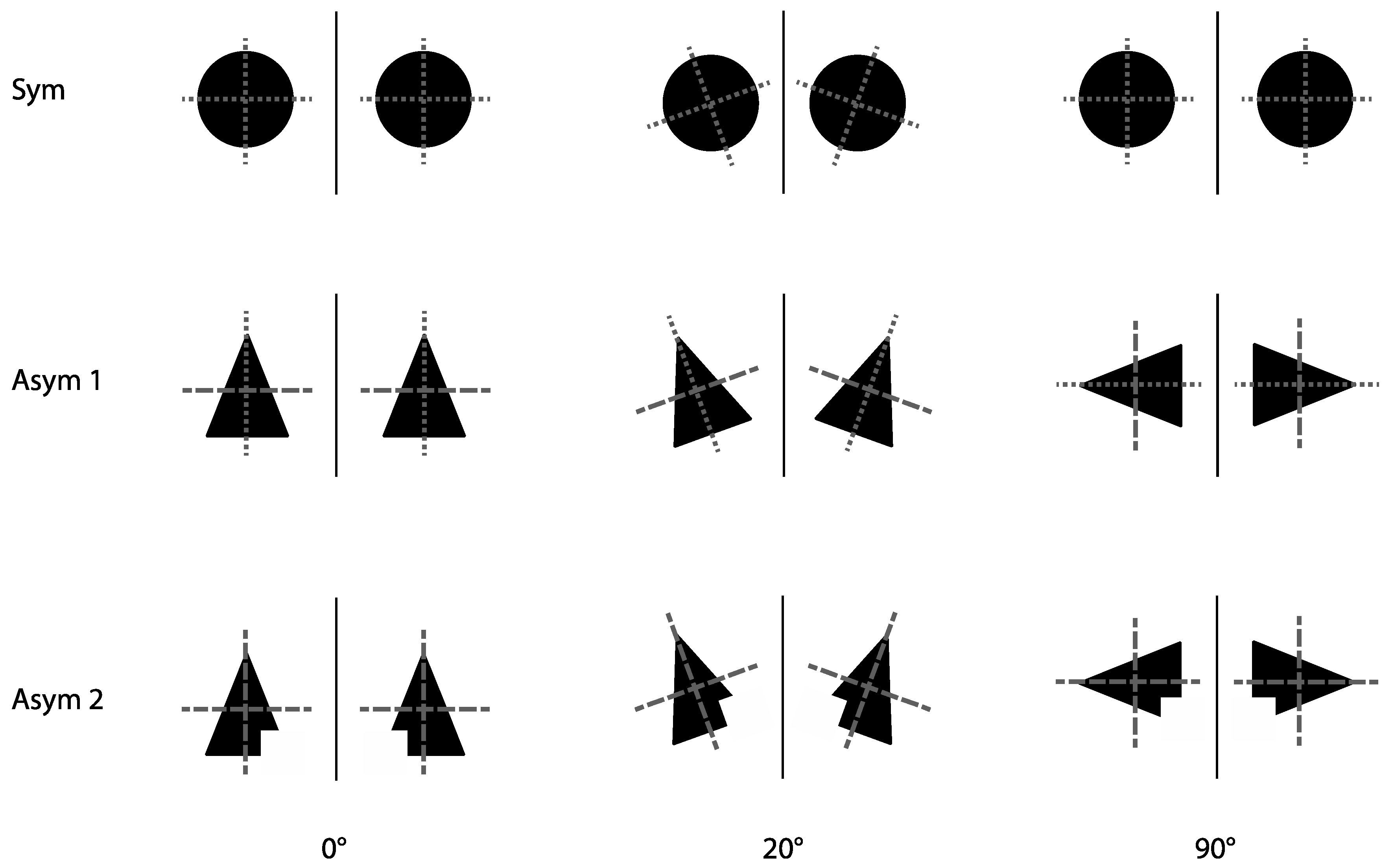
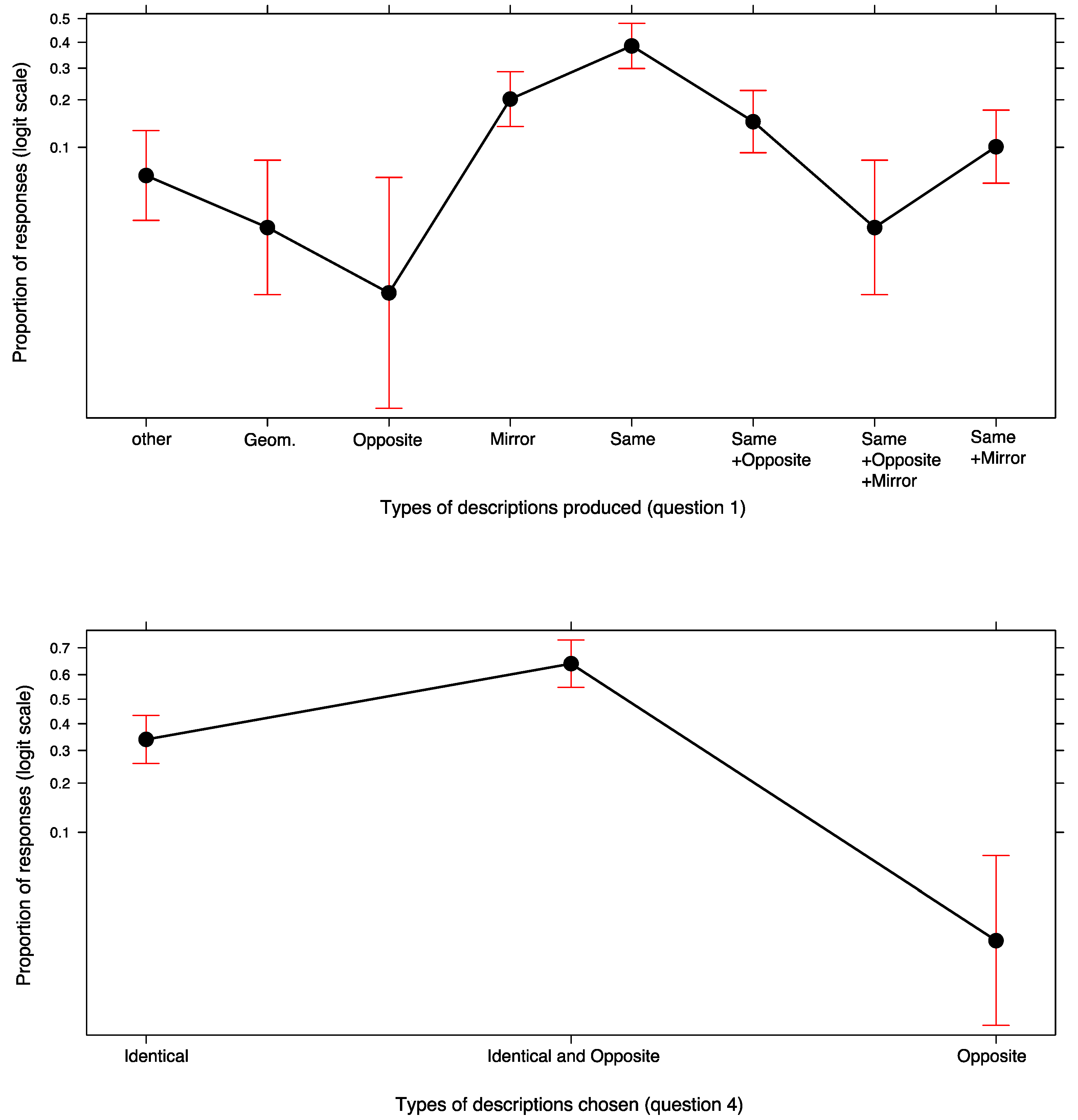
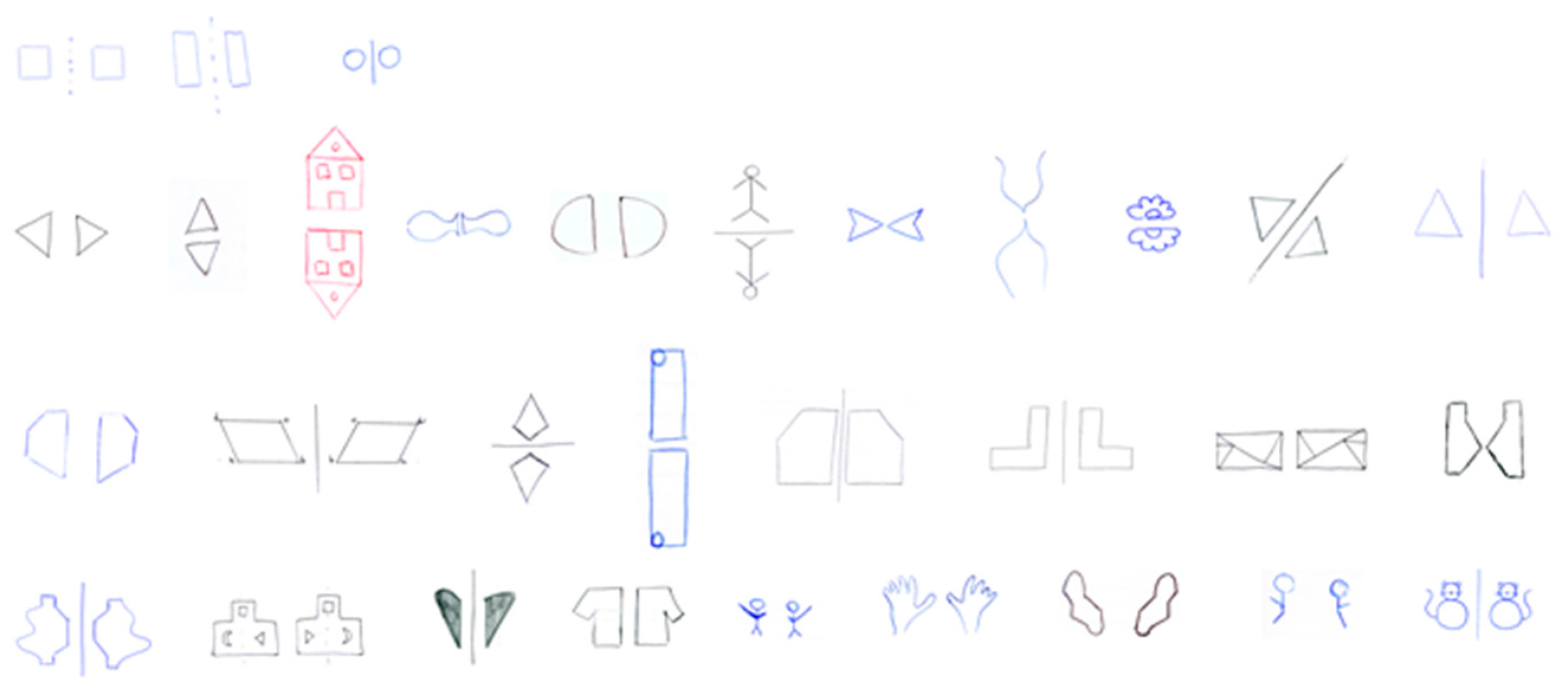
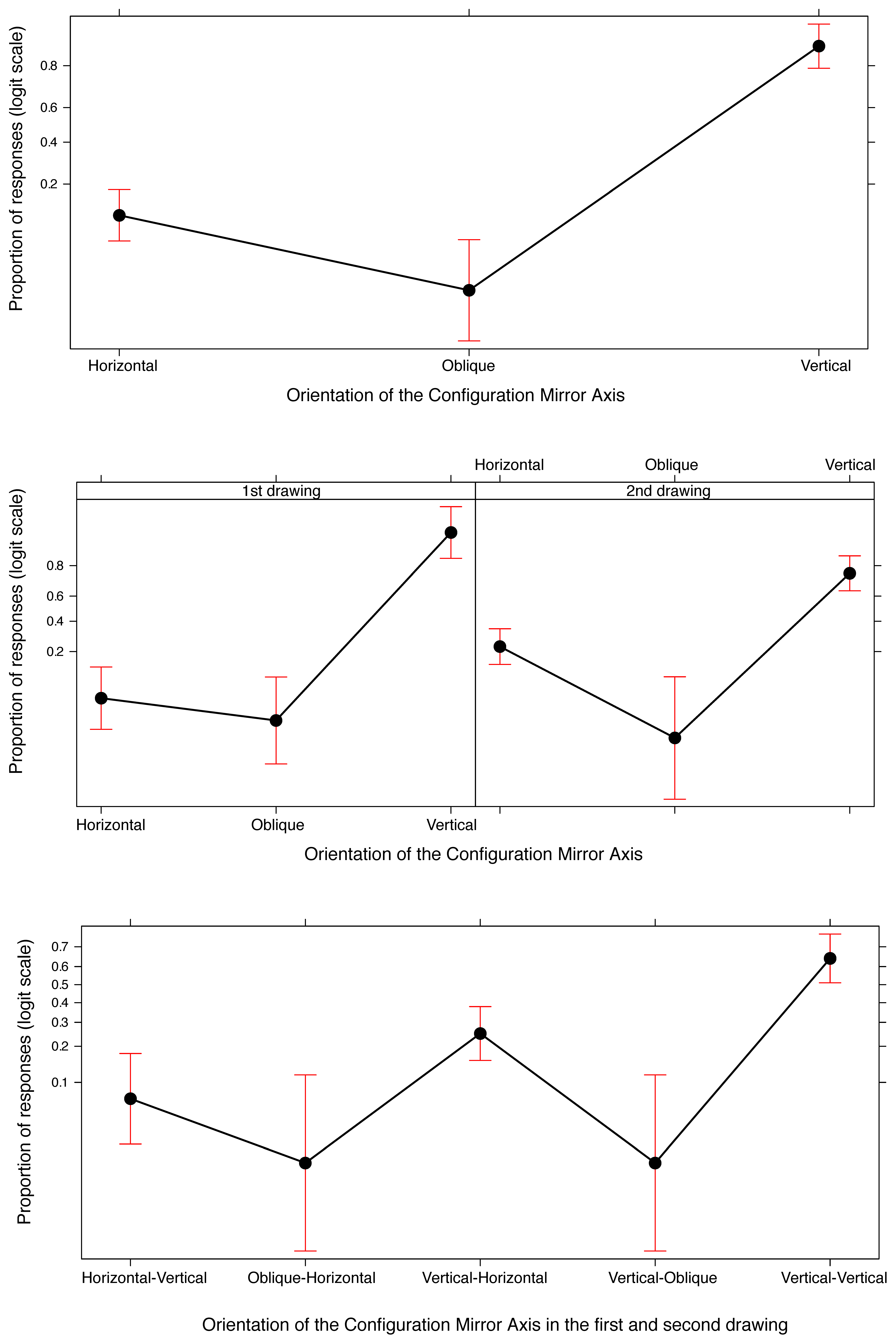
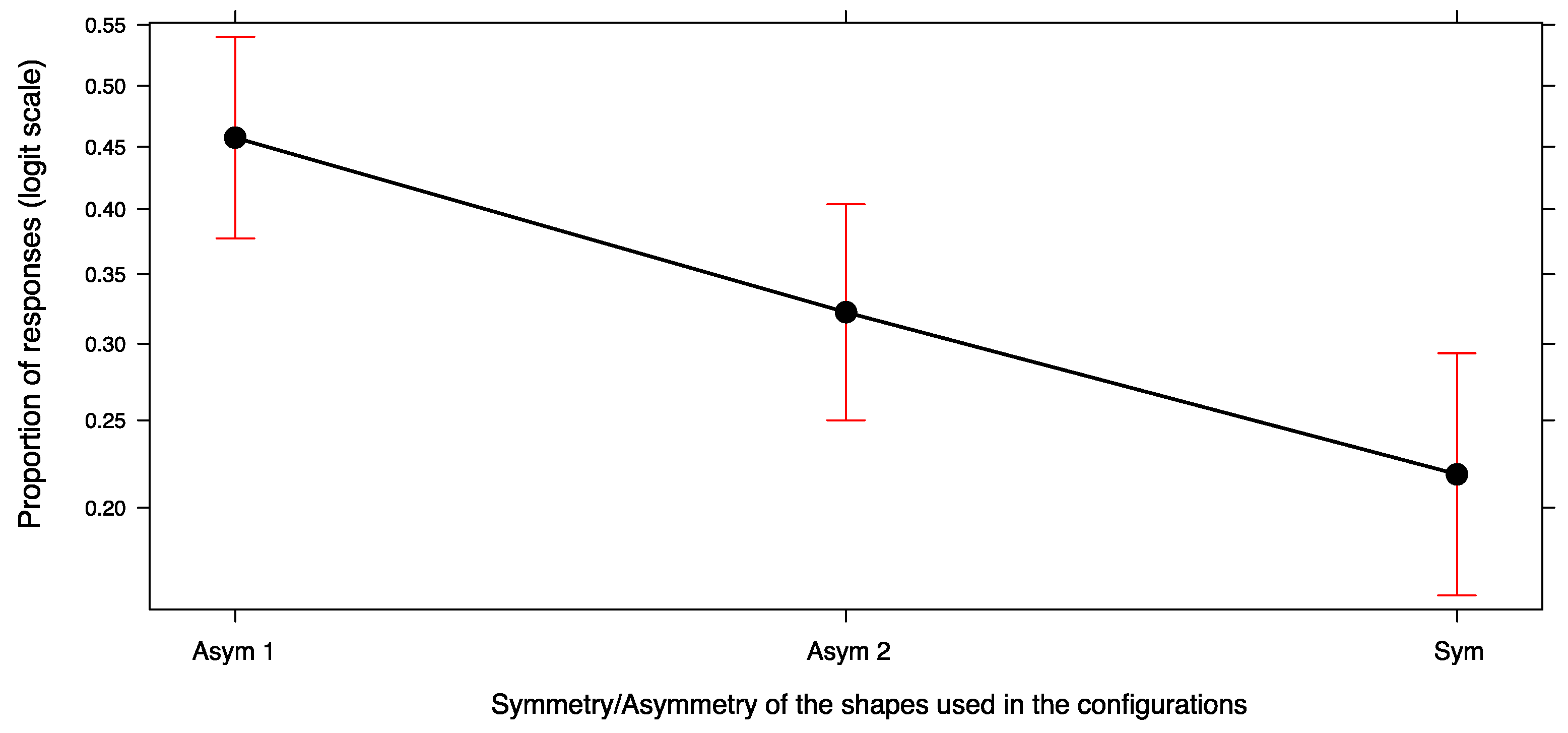


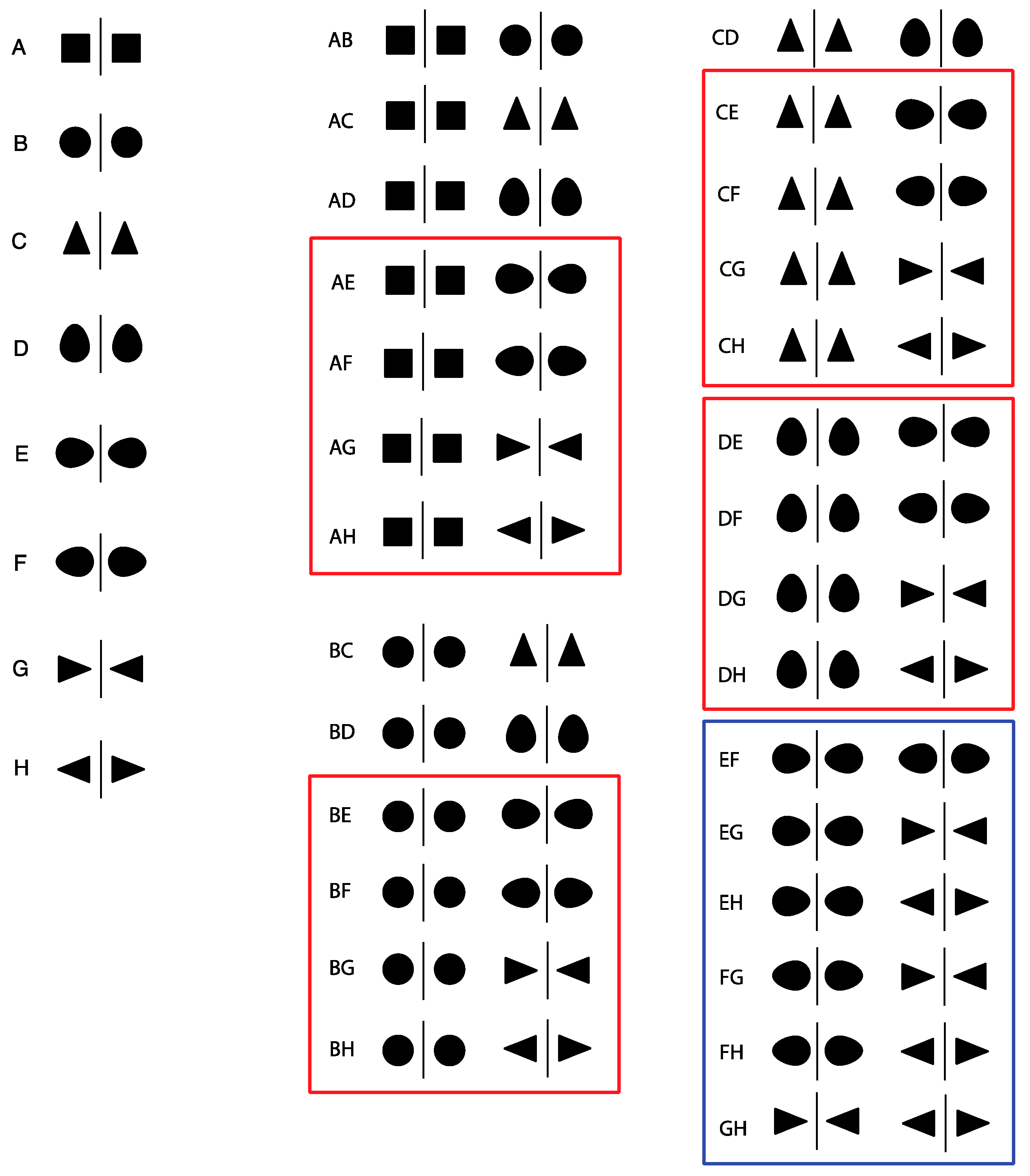
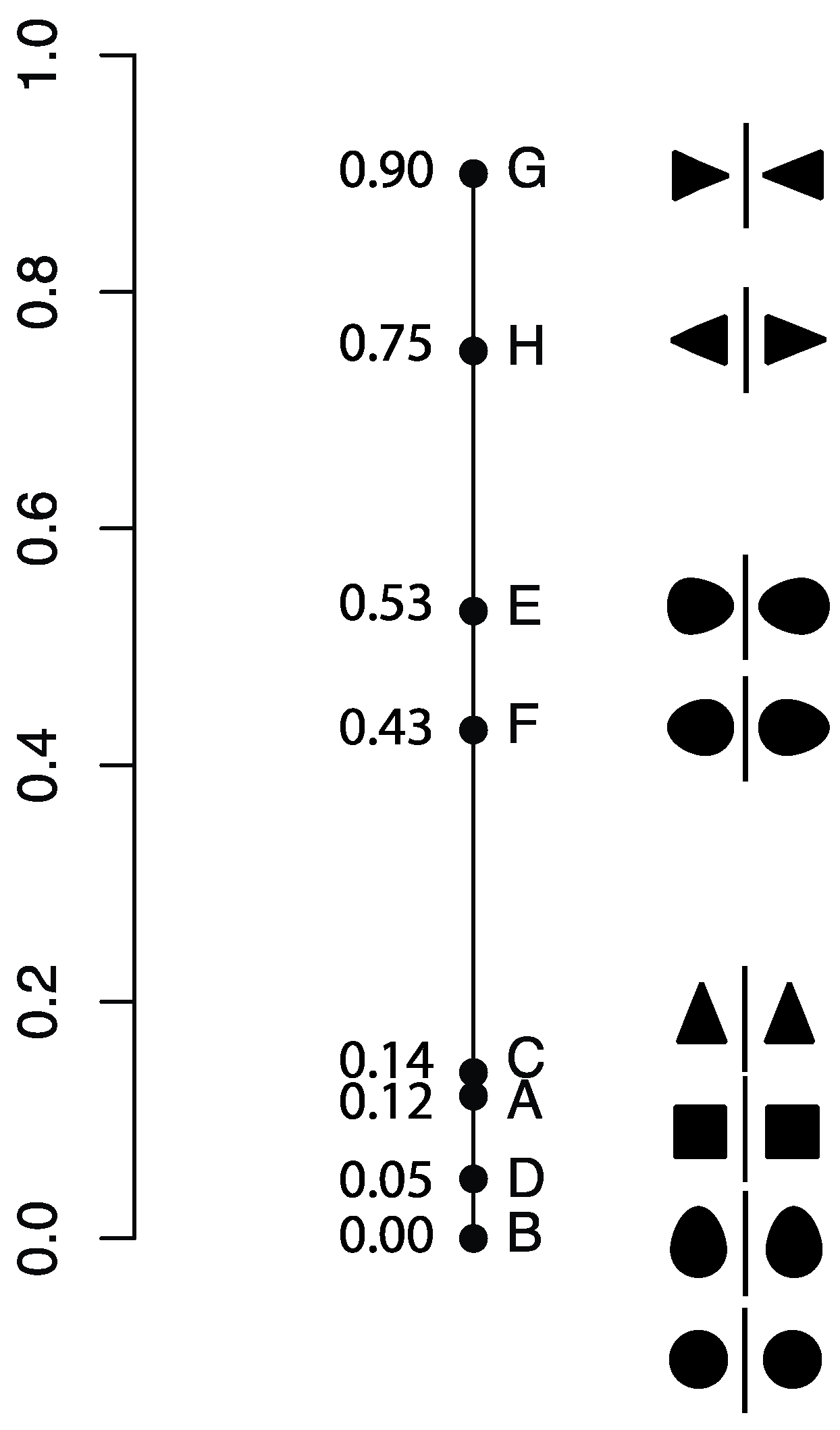
| Types of Descriptions | Examples | Counts (and %) |
|---|---|---|
| a. Geometrical | [Shapes with corresponding points at the same distance from the axis of symmetry] | 3 (2.9%) |
| b. Same | [Identical shapes] [Perfectly overlapping shapes] [Identical, coincident shapes] [shapes of the same form] [Shapes of the same form and size] | 42 (40.0%) |
| c. Mirror | [Specular shapes] [Reflected shapes] | 22 (21.0%) |
| d. Same + Mirror | [Shapes with same form and size, specular to each other] [Similar shapes, as if reflected in a mirror] [Specular/shapes with the same characteristics] | 11 (10.5%) |
| e. Opposite | [Two opposite shapes] | 1 (1.0%) |
| f. Same + Opposite | [Identical shapes, but with one reversed with respect to the other] [Same but contrary shapes] [Same and opposite shapes] [Shapes with the same features but which are inverted left to right] | 16 (15.2%) |
| g. Same + Opposite + Mirror | [Reflected shapes: identical but reversed] [Specular shapes: identical but inverted] [Equal and opposite shapes, as if reflected in a mirror] | 3 (2.9%) |
| h. Other | [Two shapes, one near the other] [Shapes which are parallel to each other] | 7 (6.7%) |
| Total | 105 | |
| Missing | (missing responses or tautological responses) | 4 |
© 2017 by the authors. Licensee MDPI, Basel, Switzerland. This article is an open access article distributed under the terms and conditions of the Creative Commons Attribution (CC BY) license (http://creativecommons.org/licenses/by/4.0/).
Share and Cite
Bianchi, I.; Bertamini, M.; Burro, R.; Savardi, U. Opposition and Identicalness: Two Basic Components of Adults’ Perception and Mental Representation of Symmetry. Symmetry 2017, 9, 128. https://doi.org/10.3390/sym9080128
Bianchi I, Bertamini M, Burro R, Savardi U. Opposition and Identicalness: Two Basic Components of Adults’ Perception and Mental Representation of Symmetry. Symmetry. 2017; 9(8):128. https://doi.org/10.3390/sym9080128
Chicago/Turabian StyleBianchi, Ivana, Marco Bertamini, Roberto Burro, and Ugo Savardi. 2017. "Opposition and Identicalness: Two Basic Components of Adults’ Perception and Mental Representation of Symmetry" Symmetry 9, no. 8: 128. https://doi.org/10.3390/sym9080128









